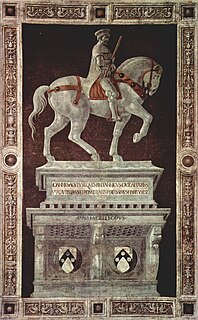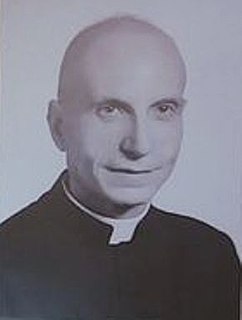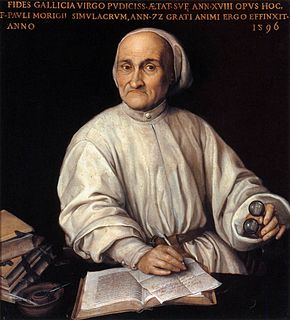
Paolo Uccello, born Paolo di Dono, was a Florentine painter and mathematician who was notable for his pioneering work on visual perspective in art. In his book Lives of the Most Excellent Painters, Sculptors, and Architects, Giorgio Vasari wrote that Uccello was obsessed by his interest in perspective and would stay up all night in his study trying to grasp the exact vanishing point. While his contemporaries used perspective to narrate different or succeeding stories, Uccello used perspective to create a feeling of depth in his paintings. His best known works are the three paintings representing the battle of San Romano, which were wrongly entitled the Battle of Sant'Egidio of 1416 for a long period of time.

Antonio d'Enrico, called Tanzio da Varallo, or simply il Tanzio was an Italian painter of the late-Mannerist or early Baroque period.

Antonio Randa was an Italian painter of the classicist period, active in Ferrara, Modena, Rovigo, Florence, Comacchio and his native Bologna.

The Funerary Monumentto SirJohn Hawkwood is a fresco by Paolo Uccello, commemorating English condottiero John Hawkwood, commissioned in 1436 for Florence Cathedral. The fresco is an important example of art commemorating a soldier-for-hire who fought in the Italian peninsula and is a seminal work in the development of perspective.
Giuliano Pisani is a writer, classical philologist, scholar of ancient Greek and Latin literature, and art historian who was born on April 13, 1950 in Verona, Italy. He graduated with a degree in ancient Greek history from Padua University with Professor Franco Sartori. He was a full professor of Greek and Latin literature at Liceo Tito Livio in Padua. Since 2011, he has been a member of the National Italian Committee of the Promoters of Classical Culture at MIUR. He was also the technical coordinator of the first Olympiad in Classical Languages and Civilizations, which was held in Venice.
In 2000 Paolo Brescia and Tommaso Principi established the collective OBR to investigate new ways of contemporary living, creating a design network among Milan, London and New York.

The Palazzo Pretorio is a historical building in Prato, Tuscany, italy. It was the old city hall, standing in front of the current Palazzo Comunale. It now accommodates the Civic Museum of Prato, which was reopened on September 2013.
Bianco di Santi alias Bianco da Siena or Bianco da Lanciolina was an Italian mystic poet and an imitator of Jacopone da Todi. He wrote several religiously-inspired poems (lauda) that were popular in the Middle Ages. First a wool carder, he eventually became a member of the poor Jesuates, founded by Giovanni Colombini.

Claudio Kevo Cavallini was an Italian sculptor. His nickname was "Kevo" with which he signed his works. At the age of 50, Claudio discovered that he could make sculptural forms from wood.

Monsignor Vincenzo Regina was an Italian presbyter and historian.

Crucifixion is a c.1457-1458 tempera on panel painting by Paolo Uccello, now in the Museo Thyssen-Bornemisza in Madrid. Its dating is debated - some date it to the same period in the Cappella dell'Assunta (1435) due to the similarities between the pose of the Virgin Mary in Crucifixion and the woman climbing the stairs in the chapel fresco of The Birth of the Virgin, whilst others date it to a later period after his return to Padua, where he was influenced by the work of Donatello.
Enzo Carli was an Italian art historian and art critic.

Minerva between Geometry and Arithmetic is a 1550 fresco fragment, usually attributed to Paolo Veronese but by some art historians to Anselmo Canera or Giambattista Zelotti. It was painted for the Palazzo de Soranzi in Castelfranco Veneto but now in the Palazzo Balbi in Venice.

Portrait of Paolo Morigia is a 1592–1595 oil on canvas painting by Fede Galizia, painted for the church of San Gerolamo in Milan and donated in 1670 to the Pinacoteca Ambrosiana in the same city, where it still hangs.
Franco Borsi (1925-2008) was an Italian architect and architectural historian. He was professor of history of architecture at the University of Florence, and wrote on Giovanni Michelucci, Leon Battista Alberti, Gian Lorenzo Bernini and Donato Bramante.

Andrea Carrera or Carreca was an Italian Baroque painter mainly active in Sicily. He was born in Trapani and died in Palermo.
This page is based on this
Wikipedia article Text is available under the
CC BY-SA 4.0 license; additional terms may apply.
Images, videos and audio are available under their respective licenses.











